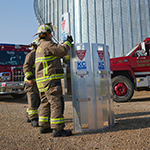Grain bin automation helps quality meet safety
Automated monitoring systems can help keep employees safe while managing stored grain.
Grain owners store grain to hedge market prices, as well as to keep harvests on schedule even if freight transport is unavailable. But improperly stored grain can be damaged by mold, insects, condensation and other factors. Too much moisture can lead to mold, for example, while excessive dryness and moisture loss causes grain to lose weight and value.
Automated grain bins have the ability to sense a dip in humidity and will shut off the fan to avoid over-drying grain. The fan will turn on automatically again when temperatures and moisture levels call for it. This automation can help ensure the value of the grain is protected and can help prevent putting people at risk by entering the bin.
Take the guesswork out of managing stored grain
Some companies say automated systems can reduce drying costs, lower the risk of grain going out of condition, minimize shrink and prevent spoilage. These systems use modern automation to reduce labor and the risk of managing natural air drying and storage.
Most systems have multiple temperature and/or moisture sensors built into the bin. Data from the sensors are gathered at a computerized controller installed on the outside of the bin, which accesses software to calculate bin conditions. Temperatures and humidity levels are gathered from an on-site weather station that in turn control the fans and other heat sources. Most systems can transmit the data to an office computer or smartphone, as well.
Grain data trends and weather patterns
By collecting historical and current data showing temperature changes through the grain, a graphical software system can also help with trends and data. It shows grain level and volume and can include tools that provide different scenarios based on historic weather patterns, as well. This information can help determine when and how much high moisture grain can be put in the bin and when to plan to dry grain down.
How much does grain automation cost?
According to Integris USA, Systems costs typically run about $0.15/bu. for facilities with a capacity under 100,000 bu. The hardware and installation costs drop to $0.05 to $0.10/bu. on a 500,000-bu. facility.
By investing in this technology, you can seamlessly and accurately monitor your investment, without dangerous hands-on or walk-in scenarios. It keeps your grain in condition and could prevent unnecessary entry into the bin. By eliminating "out of condition" grain, risks for injury or potential death are reduced, and the chances of a significant loss or product tainting are eliminated.

 >
>

 >
>
 >
>